The health club can be a confusing place. Acres of shiny machinery, weights of all shapes and sizes, people doing advanced Olympic lifts in one corner and wobble-board cable curls in another. You figure that unless you know what you’re doing, you’re better off sticking to time-tested, multijoint exercises and steering away from the trendiest equipment. And you’re right.
Still, now and then, you see someone doing a fun-looking exercise and think, “Maybe I should try that, too.”
Well — when should you?
When it’s worth the tradeoff, says Alwyn Cosgrove, MS, CSCS, co-owner of Results Fitness in Santa Clarita, Calif. “People have limited time to train,” Cosgrove says. “That often means any exercise you add to your program probably replaces something else.” So you have to be careful not to just latch onto the latest thing and toss out important movements. “There’s always going to be a hierarchy of exercises,” he adds.
Topping that hierarchy are the multijoint, multi-muscle-group exercises many regular exercisers know by heart: pushups, lunges, squats, presses, rows and plank variations, to name a few. But are there other equally effective exercises you could sub in from time to time to challenge your body in new ways?
The answer is a resounding yes! There are plenty of often-overlooked but highly effective exercises worth a place in your rotation, and following are six of the best options. They were recommended by four of the most innovative trainers in the industry and have been road-tested on pro athletes and average gym-goers alike.
Our experts explain how to execute these movements, what they’re good for and which conventional exercise each one most closely replicates (you don’t want to replace your squats with sit-ups, after all).
There are options here for your lower body, your upper body and your core, so no matter what’s on the docket for today, you’ll have a testing ground for some alternatives. Work these exercises into your routine and the trainers at your health club just might start hitting you up for advice.
Lower Body
Bulgarian Dead Lift
 How to do it:
How to do it:
- Stand with your back 2 to 3 feet from a bench or an aerobic step no taller than knee height.
- Extend your left leg behind you and place your foot on the step.
- Bend your knees slightly, square your hips and shoulders, and balance your weight between your feet.
- Keeping your back neutral throughout the movement, bend forward at the hips and extend your hands toward the floor, stopping the movement when you start to lose the natural arch in your lower back.
- Return to the starting position by pushing through the heel of your
front foot. - Perform eight to 15 repetitions, switch legs, and repeat for a total of two or three sets. Make it harder by holding dumbbells.
For another powerhouse unilateral exercise see “BREAK IT DOWN: How to Do the Bulgarian Split Squat“.
Why it’s worthwhile: Single-leg exercises are popular among coaches because they are easier on the lower back than barbell squats and dead lifts. But many single-leg movements — like lunges and step-ups — primarily work the quadriceps (the muscles on the front of the thigh), while minimally stressing the glutes and hamstrings. “If you’re looking for a single-leg exercise for the glutes and hamstrings, your only real option is the single-leg Romanian dead lift, which for many people challenges balance more than strength. As a result, the target muscles never really get a good workout,” says Cosgrove. Bulgarian dead lifts solve this problem: The forward hip-hinge maximally fires up your glutes and hamstrings, and with your back foot stabilized on the bench behind you, you’ll be able to use a substantial weight without losing your balance.
Substitute for: Other variations of the dead lift
Pull-Through

How to do it:
- Connect a two-handled rope attachment to a cable column machine and set the pulley at its lowest position.
- Face away from the machine, straddling the cable, and reach through your legs to take hold of the rope with both hands, using an overhand, neutral grip (the knobbed ends of the rope should be on the thumb-sides of your hands).
- Assume a shoulder-width-and-a-half stance with your toes pointed slightly outward, and step forward a foot or so (rather, hobble forward — it won’t be easy to walk in this position) until the weight you’ve selected lifts several inches off the stack.
- Keeping your back straight, your chin neutral, and your shoulder blades pulled back and down, push your hips back and lean forward as far as you can without losing the natural arch in your lower back. Your arms should reach back toward the machine.
- Allow your knees to bend slightly, and the hamstrings and adductors — the muscles on the insides of your thighs — to stretch comfortably.
- Return to the standing position by thrusting the hips forward, squeezing your glutes together and pulling the rope handles through your legs. “I don’t worry too much about big weights on this exercise,” says Tony Gentilcore, CPT, CSCS, cofounder of Cressey Performance in Hudson, Mass. “The important thing is getting quality reps: Pull from your hips, not your arms or lower back, and shoot for three sets of 10 to 15 reps.”
Why it’s worthwhile: “This is one of the most underrated exercises of all time,” says Gentilcore. The reason? Safe and effective posterior-chain activation. The posterior chain — all your rear-view muscles from your knees to your midback — is a physiological jack-of-all-trades: Developing these muscles can make you a faster runner, ease lower-back pain and improve your posture. Many gym-goers, however, find traditional posterior-chain movements (think conventional dead lifts) tough on their lower backs. Pull-throughs circumvent this problem, targeting the posterior chain without over-stressing the lower back, and also promoting hip mobility — a proven key to back and knee health. “It’s a unique-looking exercise,” he admits, “but it’s incredibly versatile.”
Substitute for: Romanian dead lifts, kettlebell swings
Upper Body
Angled Shoulder Press
 How to do it:
How to do it:
- Attach one end of a barbell bar into a ground-based rotational device (often called a landmine).
- Facing the bar, lift the opposite end of the bar to shoulder height and assume a neutral grip on the bar with your right hand near the end of the bar. Your right forearm should be perpendicular to the bar, feet shoulder-width apart.
- Bend your knees slightly, tighten your core, and press the bar up and forward until your elbow is locked.
- Lower the bar to shoulder height and perform six to 12 repetitions.
- Switch arms and repeat for a total of two or three sets. Make the movement harder by loading the raised end of the bar.
Why it’s worthwhile: Many people find traditional overhead presses uncomfortable because they can wreak havoc on inflexible shoulder joints. “The angled press allows the shoulder to follow its natural arc, making it a very comfortable exercise, even for people who have shoulder problems,” says Nick Tumminello, NSCA-CPT, a performance coach in Baltimore. As with the overhead press, the focus of the exercise is your “pushing” muscles — the shoulders, chest and triceps — but pressing with just one hand presents an additional challenge: “Since the weight is off-center, your core has to work extra hard to keep you upright,” says Tumminello.
Substitute for: Incline bench press, overhead press
Equipment Option: A landmine can be a tough piece of equipment to locate, so talk to your health club about acquiring one; or, just wrap the end of the barbell in a towel and wedge the end into a corner instead.
Cable Face Pull
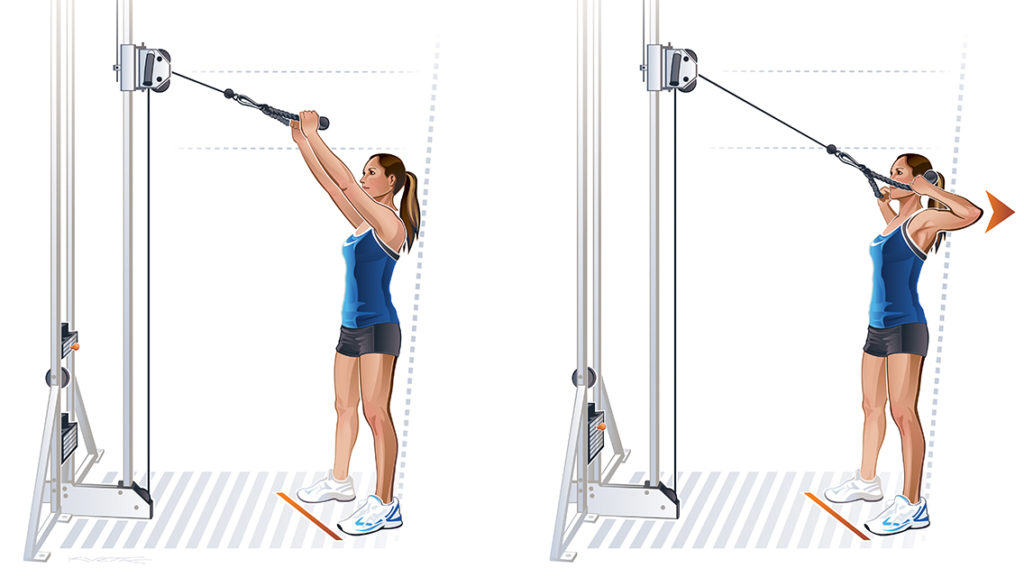
How to do it:
- Set the pulley on an adjustable cable machine a few inches to a foot above your head, and connect a two-handled rope attachment (often used for triceps pushdowns) to the cable.
- Grip the ends of the rope so your thumbs are against its knobbed ends and, facing the machine, step back until your arms are fully extended and the weight you’ve selected lifts a few inches off the stack.
- Lean back slightly and assume a staggered, athletic stance: one foot forward, the other slightly back, chin neutral, back straight, shoulder blades pulled down and together.
- Maintaining this upright posture, draw your elbows back as far as possible, keeping them slightly above shoulder height throughout the movement. The middle of the rope attachment — where it connects to the cable — should come directly toward your nose (if you’re flexible, your nose might even graze it).
- Lower the weight under control, allowing the shoulder blades to abduct (wing slightly away from the middle of your back) when your arms are extended. Gentilcore suggests keeping the weight low to moderate for two to three sets of 10 to 15 reps per set, focusing on excellent form throughout.
Why it’s worthwhile: All the hours we spend commuting, desk jockeying and TV watching conspire to pull even the most posture-conscious among us into a habitual slouch. “We’re a flexion-dominant society,” says Gentilcore. And what we do in the gym often compounds the problem: “Most people do nothing but bench presses, lat pulldowns, curls and crunches in the gym,” he explains — all exercises that further force us into that curled-forward, semi-fetal position.
Face pulls are posture savers: By targeting the upward rotators — the muscles that pull the shoulder blades down and back — they help counterbalance chronic rounding in the back and shoulders, thus reinforcing healthier postural habits.
Substitute for: Overhead presses, rows
Core
Pallof Press
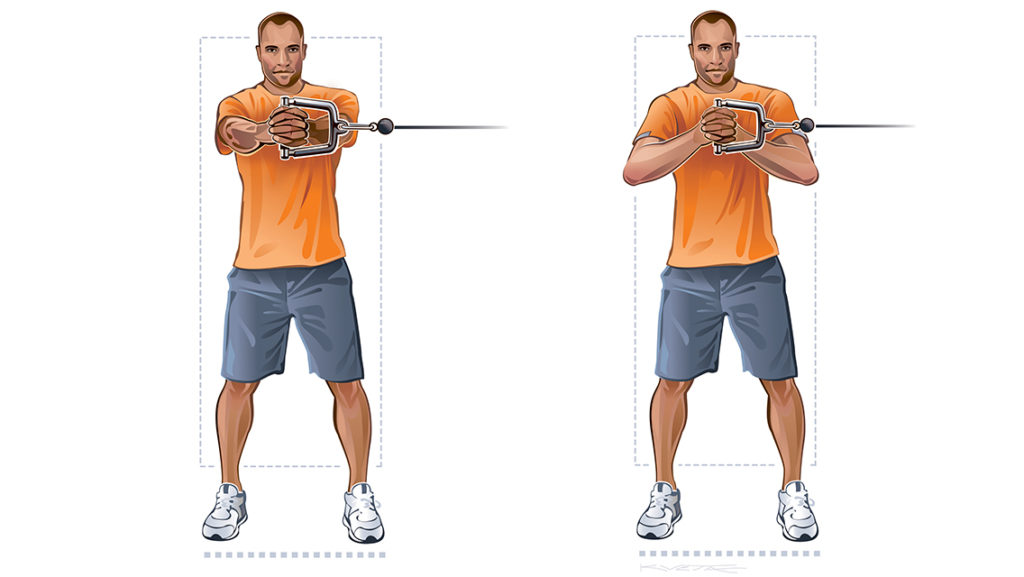
How to do it:
- Set the pulley on a cable machine to chest height and attach a D-handle (the steel attachment with a rotating handle typically used for one-handed cable exercises) to the cable.
- Interlock the fingers of both hands around the handle, walk back several feet to create tension on the cable, and turn your body so that your left shoulder points toward the machine.
- Assume an athletic stance (knees slightly bent, chin neutral, back upright, shoulder blades back and down, feet shoulder-width apart) and hold the D-handle against your torso at sternum height, its handle vertical.
- Slowly extend your arms, keeping your hands directly in the middle of your chest, maintaining an upright posture and keeping the D-handle vertical throughout the movement. Pause in the fully extended position for a moment, then slowly bring the handle back to the starting position.
- Repeat for two or three sets of 10 to 15 repetitions on each side.
Why it’s worthwhile: “This move teaches people to resist rotation in the core musculature,” says Gentilcore. Since the core’s main function is to brace the spine for stability, anti-rotation exercises like this one are essential in preventing injury to the lower back.
Substitute for: Side plank, bus drivers (also good to work into your current core routine)
Equipment Option: If your health club doesn’t have an adjustable-height cable machine, just loop a resistance band around a sturdy pole, as pictured here.
Tight Rotations
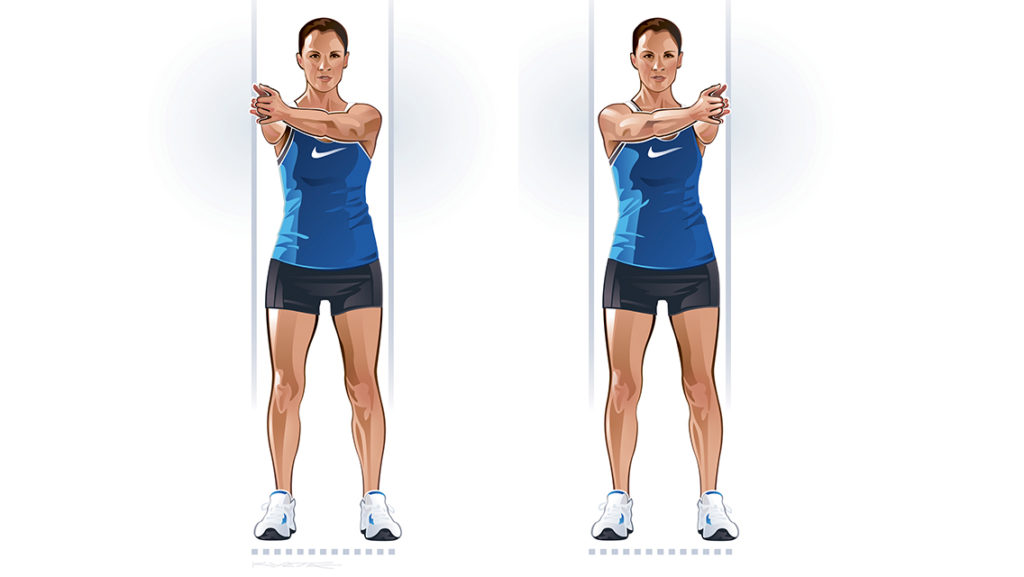
How to do it:
- Stand with your feet shoulder-width apart, knees slightly bent, back straight.
- Extend your arms in front of your chest and press the palms of your hands firmly together. “Imagine you are standing between two walls that almost touch your shoulders,” says Tumminello.
- Keeping your palms pressed together and your hips facing forward, rapidly rotate your upper torso left and right so that your hands oscillate as fast as possible between the two imaginary walls at your sides.
- Work up to multiple sets of 10 seconds or so, shooting for around 30 quick repetitions per side in each 10-second interval. Make it harder by holding a light medicine ball or body bar, but don’t use so much weight that it slows you down significantly: “Moving quickly is important,” says Tumminello.
Why it’s worthwhile: Almost all sports, and many everyday activities — walking and running, for instance — require you to stabilize the core in the transverse (rotational) plane as your upper body turns rapidly back and forth over a short range of motion. “Only the tight rotation exercise accurately mimics the fast, tight turning motion that you see over and over again in life and in athletics,” says Tumminello.
Substitute for: Cable chop
The Case for Change
From the lay-up to the topspin forehand, every athletic endeavor has its fundamentals, and that’s as true in strength training as it is in basketball or tennis. The basics are the basics, after all, because they work.
But if you’re looking to change things up — and variety in a strength-training routine is essential to optimal progress — these six exercises are a great place to start.
The Mark of a Good Exercise
How can you tell a smart resistance move from a fussy waste of time? According to experts, the best exercises share a handful of traits:
Scalable: The best exercises can be adjusted to accommodate any level of fitness. Take the sled push, says Sara Wiley, MS, CSCS, associate director of strength and conditioning for athletics at the University of Minnesota. “A beginner might push slowly, whereas a high-level athlete might do an all-out sprint.”
Versatile: It’s a good sign when you can make an exercise harder or easier without racking and reracking weights. For instance, you can modify the humble pushup in almost unlimited ways: Elevate the feet to make it harder, or raise the hands to make it easier. Explode off the floor and make it a power exercise.
Understandable: “Even novices can often feel if the body moves and grooves well during a given exercise,” says Baltimore-area strength coach Nick Tumminello, NSCA-CPT.


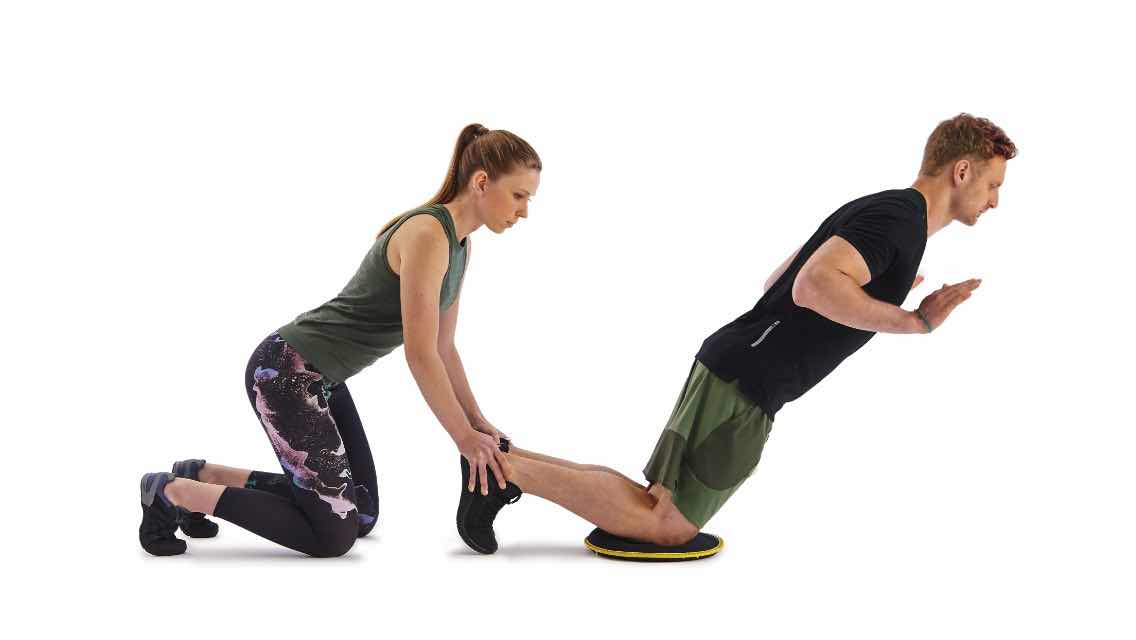
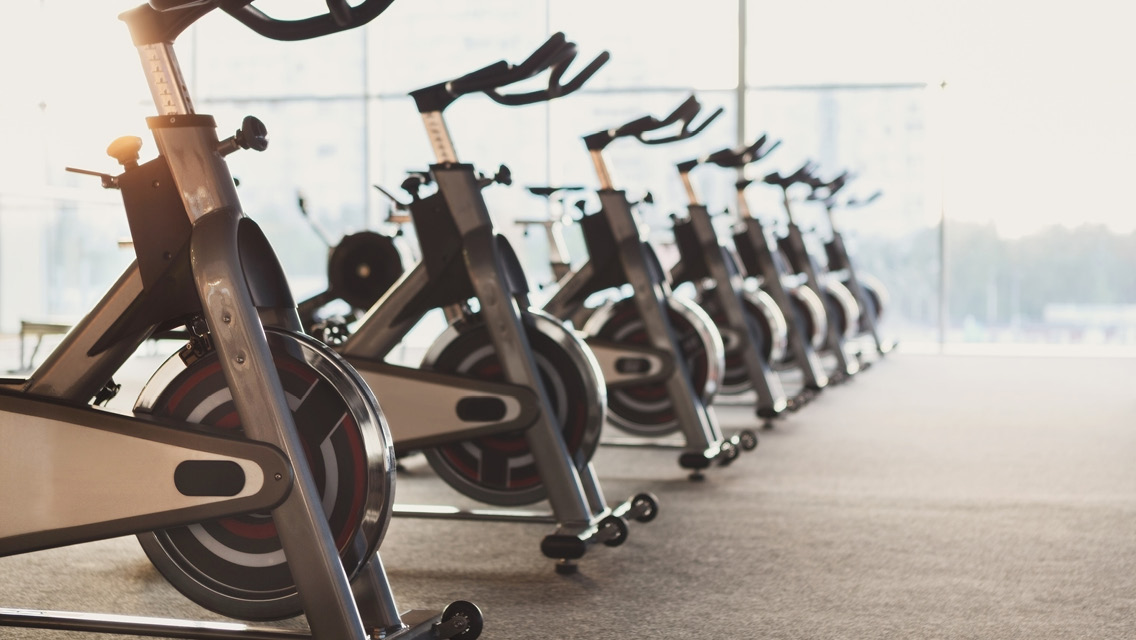
This Post Has 0 Comments